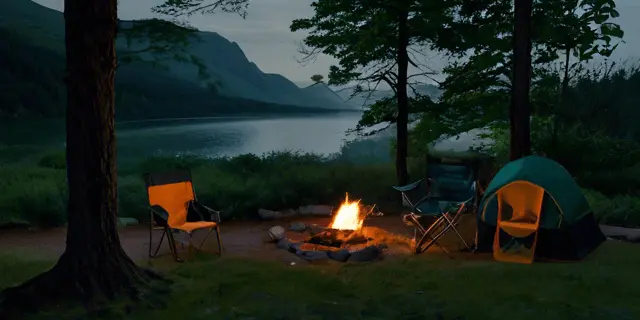Conscious Camping: Leaving No Trace in the Great Outdoors

Imagine stepping into a pristine forest, breathing in the crisp mountain air, and feeling completely at one with nature. Now, picture that same forest littered with trash, trampled vegetation, and disturbed wildlife. The difference is stark, isn’t it? This is where “Leave No Trace” camping comes into play – a set of principles that help us enjoy the great outdoors while minimizing our impact on the environment.
In this blog post, we’ll explore the art of conscious camping and how you can become a steward of nature through eco-friendly outdoor practices. Whether you’re a seasoned camper or a novice adventurer, these guidelines will help you preserve the beauty of our wilderness for future generations to enjoy.
Understanding the Leave No Trace Principles
The Leave No Trace movement began in the 1960s when public land use in the United States started to increase dramatically. Concerned about the impact of this surge in outdoor recreation, the U.S. Forest Service, National Park Service, and Bureau of Land Management developed a program to educate visitors about their environmental impact.
The seven core principles of Leave No Trace are:
- Plan Ahead and Prepare
- Travel and Camp on Durable Surfaces
- Dispose of Waste Properly
- Leave What You Find
- Minimize Campfire Impacts
- Respect Wildlife
- Be Considerate of Other Visitors
These principles form the foundation of sustainable wilderness exploration and help us minimize our footprint in nature.
Plan Ahead and Prepare
Proper planning is the cornerstone of any successful and eco-friendly camping trip. By preparing thoroughly, you can reduce waste, minimize resource damage, and ensure a safe and enjoyable experience.
Here’s a checklist of essential items for your eco-conscious camping trip:
- Reusable water bottles and water filtration system
- Biodegradable soap and toiletries
- Trash bags for packing out waste
- Durable, reusable food containers
- Maps and compass (or GPS device)
- First-aid kit
- Weather-appropriate clothing
- Emergency shelter
When it comes to meal planning, consider these tips to minimize waste:
- Pre-portion your meals at home to avoid bringing excess food.
- Use reusable containers instead of disposable plastic bags.
- Opt for foods with minimal packaging or remove packaging before your trip.
- Plan no-cook meals or one-pot recipes to reduce the need for cleaning up.
By following these guidelines, you’ll not only reduce your environmental impact but also lighten your load, making your camping experience more enjoyable.
Travel and Camp on Durable Surfaces
When exploring the great outdoors, it’s crucial to minimize your impact on the land. Durable surfaces are areas that can withstand repeated use without significant damage. These include:
- Established trails and campsites
- Rock, gravel, or sand
- Dry grasses or snow (depending on the season)
When choosing a campsite, follow these guidelines:
- Camp at least 200 feet away from lakes, streams, and trails.
- Look for areas of bare soil, rock, or hardy grass.
- Avoid camping on fragile vegetation or cryptobiotic soil crust.
- Use existing tent sites when available.
- Limit your stay to no more than two nights in one spot.
While hiking, remember to:
- Stay on designated trails to prevent erosion and protect vegetation.
- Walk single file in the middle of the trail, even when it’s wet or muddy.
- If you must travel off-trail, spread out to avoid creating new trails.
By following these practices, you contribute to sustainable wilderness exploration and help preserve the natural beauty for future visitors.
Dispose of Waste Properly
Proper waste disposal is a cornerstone of Leave No Trace camping. The golden rule here is “Pack it in, Pack it out.” This means carrying out everything you bring into the wilderness, including:
- Food scraps and peels
- Used hygiene products
- Empty containers and packaging
- Toilet paper and wipes
For human waste disposal, follow these steps:
- Dig a cathole: 6-8 inches deep and 4-6 inches in diameter, at least 200 feet from water sources, campsites, and trails.
- Do your business: Use the hole for solid waste and toilet paper.
- Cover and disguise: Fill the hole with the original dirt and cover with natural materials.
In high-use areas or sensitive ecosystems, consider using waste bags or carrying out human waste.
For washing dishes and personal hygiene:
- Use biodegradable soap sparingly.
- Wash at least 200 feet away from water sources.
- Strain dishwater and pack out food particles.
- Scatter greywater widely to allow for natural filtration.
Remember, even biodegradable products can harm aquatic ecosystems, so always minimize their use and dispose of them properly.
By diligently managing your waste, you play a crucial role in preserving the pristine nature of our wilderness areas and promoting eco-friendly outdoor practices.
Leave What You Find
One of the joys of camping is discovering the wonders of nature. However, it’s crucial to remember the adage: “Take only pictures, leave only footprints.” This principle is vital for preserving both natural and cultural artifacts.
Here are some guidelines for responsible nature observation:
- Observe, don’t disturb: Resist the urge to pick flowers, collect rocks, or disturb natural formations.
- Use cameras or sketchbooks to capture memories instead of taking physical souvenirs.
- Leave natural objects and artifacts where you find them for others to enjoy.
- Avoid introducing non-native species by cleaning your gear between trips.
To enjoy nature without disturbing it:
- Use binoculars for a closer look at wildlife and plants.
- Stay on designated trails to avoid trampling sensitive vegetation.
- Learn about the local ecosystem before your trip to appreciate its uniqueness.
By leaving nature untouched, you contribute to the preservation of ecosystems and allow future generations to experience the same wonder you did.
Minimize Campfire Impacts
Campfires are often seen as an essential part of the camping experience. However, they can have significant impacts on the environment. Consider these points when deciding between a campfire and a camp stove:
| Campfire | Camp Stove |
|---|---|
| Traditional experience | More eco-friendly |
| Requires wood collection | Portable and efficient |
| Can scar the landscape | Minimal impact on surroundings |
| Fire risk in dry conditions | Safer in most conditions |
If you do choose to have a campfire, follow these proper fire-building techniques:
- Use existing fire rings or pits when available.
- Keep fires small and manageable.
- Collect only dead and downed wood no larger than your wrist.
- Burn all wood to ash; don’t let it smolder.
To completely extinguish a campfire:
- Drown the fire with water, not dirt.
- Stir the ashes and embers.
- Feel for heat with the back of your hand.
- Repeat steps 1-3 until the fire is completely out.
Remember, a truly eco-friendly outdoor practice often means forgoing the campfire altogether and opting for a camp stove or no fire at all.
Respect Wildlife
Observing wildlife in their natural habitat can be a thrilling experience. However, it’s crucial to do so responsibly. Follow these guidelines for safe wildlife observation:
- Keep your distance: Use binoculars or zoom lenses to view animals from afar.
- Never feed wildlife: Human food can harm animals and alter their natural behaviors.
- Control pets: Keep them on a leash or leave them at home.
- Avoid wildlife during sensitive times: Such as mating, nesting, or raising young.
Proper food storage is essential to avoid attracting animals to your campsite:
- Use bear-resistant containers or hang food bags at least 10 feet high and 4 feet from the trunk of a tree.
- Store scented items (including toiletries) with your food.
- Cook and eat away from your sleeping area.
If you encounter wildlife:
- Stay calm and give the animal space.
- Slowly back away while keeping an eye on the animal.
- Make yourself look big and make noise if the animal approaches.
- Never run, as this may trigger a predatory response.
By respecting wildlife and their habitats, you ensure that future campers can enjoy the same incredible experiences with nature’s creatures.
Be Considerate of Other Visitors
When practicing Leave No Trace camping, it’s important to remember that we share the wilderness with others. Being mindful of fellow outdoor enthusiasts enhances everyone’s experience. Here are some guidelines:
- Yield to others on trails: Uphill hikers have the right of way.
- Keep noise to a minimum: Enjoy nature’s sounds and let others do the same.
- Be mindful of your group size: Large groups have a bigger impact on both the environment and other visitors.
To minimize noise pollution:
- Speak in low voices, especially in the early morning and late evening.
- Leave noisy electronics at home or use headphones.
- If you bring a pet, ensure it’s well-behaved and quiet.
Remember, part of the wilderness experience is disconnecting from the hustle and bustle of daily life. By being considerate, you help preserve the serenity of nature for all.
Eco-Friendly Camping Gear
Choosing the right gear can significantly reduce your environmental impact. Here’s a list of recommended eco-friendly products:
| Product | Features | Benefits |
|---|---|---|
| Solar-powered lantern | Rechargeable, long-lasting | Reduces battery waste |
| Bamboo utensil set | Durable, biodegradable | Eliminates need for disposable plastics |
| Recycled polyester tent | Made from recycled materials | Reduces new plastic production |
| Natural insect repellent | DEET-free, plant-based | Less harmful to environment and skin |
| Biodegradable soap | Phosphate-free, natural ingredients | Minimizes water pollution |
Investing in high-quality, sustainable gear not only benefits the environment but often leads to a more enjoyable camping experience.
Teaching Children About Leave No Trace
Instilling eco-friendly outdoor practices in children from a young age is crucial for the future of our wilderness areas. Here are some age-appropriate activities:
- Scavenger hunt: Create a list of natural items for kids to find and photograph, not collect.
- “Leave No Trace” relay races: Set up stations where kids practice different principles.
- Nature art: Use found objects to create temporary art, then disassemble and scatter the items.
To make conservation fun:
- Turn it into a game: Who can spot and pick up the most micro-trash?
- Encourage storytelling about the animals and plants they observe.
- Involve kids in meal planning and waste reduction strategies.
By making these principles engaging and fun, we can raise a generation of responsible, nature-loving campers.
Conclusion
Conscious camping and adhering to Leave No Trace principles are not just about preserving nature – they’re about fostering a deep connection with the wilderness and ensuring that future generations can experience its wonders. By planning ahead, minimizing our impact, and being mindful of our surroundings and fellow visitors, we can all play a part in protecting our precious natural spaces.
As you embark on your next outdoor adventure, challenge yourself to implement these practices. Remember, every small action counts towards the bigger picture of conservation. Let’s commit to being stewards of the environment, leaving each campsite better than we found it.
Additional Resources
For more information on Leave No Trace camping and eco-friendly outdoor practices, check out these valuable resources:
- Leave No Trace Center for Outdoor Ethics: The official site for Leave No Trace principles and education.
- National Park Service – Leave No Trace: In-depth explanations of the seven principles.
- iNaturalist App: A citizen science app for identifying plants and animals in the wild.
Remember, the more we learn about and practice sustainable wilderness exploration, the better equipped we are to protect and preserve our natural world for generations to come. Happy (and conscious) camping!



